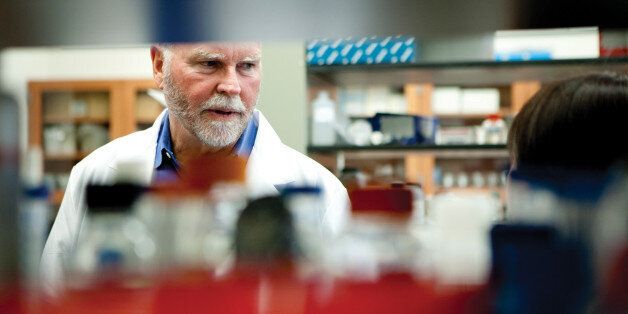J. Craig Venter is best known for sequencing the human genome. He is founder, chairman and CEO of the J. Craig Venter Institute and Synthetic Genomics, Inc. His most recent book is “Life at the Speed of Light: From the Double Helix to the Dawn of Digital Life.”
He recently spoke with The WorldPost:
WORLDPOST: With what you call the “dawn of digital life” and the fusion of the digital world with biology, you say we are entering a new phase of evolution? What do you mean?
J. CRAIG VENTER: Biological evolution has taken 3.5 or 4 billion years to get us where we are. The adaption of our species to the social environment — social evolution — has been much faster. Now that we can read and write the genetic code, put it in digital form and translate it back into synthesized life, it will be possible to speed up biological evolution to the pace of social evolution.
“We are actually creating new genes and enzyme functions that don’t exist in nature at all. We’re dealing with the design of organisms based on the functions we want. This is something that would never occur on its own in nature. And we can speed up the glacial process that would occur in nature by orders of magnitude.”
On a theoretical basis, that gives us control over biological design. We can write DNA software, boot it up to a converter and create unlimited variations on biological life.
In 2010, we created the first synthetic cell, and it is a forward extrapolation from there. We’ve been able already to change cells so they produce human insulin and will be able to, in due course, redesign the genetic code to change how we produce food, fuels and chemicals.
We are now engaged in finding new ways to head off pandemics by being able to read the code of flu strains and very rapidly produce vaccines to stop them. We are doing this with Novartis. We have already done the first round of clinical trials on the new H7N9 vaccine based on the work of Chinese scientists who sequenced isolates from the Avian flu outbreak there in 2013. We received the sequence from them in digital form by email and converted it back into DNA to produce the vaccine in about 10 hours. Novartis is already scaling up the vaccine before we’ve had a single outbreak in the U.S.
That is the opposite of what happened with H1N1 when we didn’t have a vaccine until two months after the pandemic had peaked.
In effect, what we are we doing is “teleporting DNA.” There are two components to this process: the sending unit and the digital biological converter.
In November, we completed a teleporting test in the Mojave desert — the closest environment we have to Mars on Earth — with NASA. We took a sample of algae that can be grown under clear quartz because the light penetrates the rock and the algae is protected from exposure to the heat and elements on the surface. We chipped off a piece of algae, isolated the DNA genome sequence out there in the desert and then sent it up to the Cloud. Back in our labs in La Jolla, we downloaded the sequence and have been reconstructing the algae genome in the computer in automated fashion.
Our hope is that in the future, a NASA probe on Mars will take similar samples of microbes — which I strongly suspect will be DNA based — and beam them back to our lab to reconstruct whatever life form there is in our labs. When Mars and Earth are closest to each other, that will take 4.3 minutes by electromagnetic signal. That is life at the speed of light.

WORLDPOST: What you are really talking about is something akin to “horizontal gene transfer” through human intervention — sharing information from one species to another.
VENTER: We are really doing more than that. We are actually creating new genes and enzyme functions that don’t exist in nature at all. We’re dealing with the design of organisms based on the functions we want.
This is something that would never occur on its own in nature. And we can speed up the glacial process that would occur in nature by orders of magnitude.
WORLDPOST: The glacial pace of evolution that took place over billions of years was based on natural selection. What didn’t work, didn’t survive. This is the accelerated evolution of un-natural selection.
Human purpose, with the necessary limits of our knowledge, is now projecting mutations with unknown effects into an overall bio-system of which we have incomplete knowledge of all the feedback loops. Even now in your work, in the simplest cell, you are unable to determine the function of 50 genes.
Gregory Bateson, the anthropologist and cybernetic systems theorist, warned that “lack of systemic wisdom is always punished.” Do you worry about the consequences?
VENTER: This is the right question. There are lots of ways to deal with it. We are trying to build kill switches into organisms or chemical dependency so they can’t survive outside a lab or a factory — something that natural evolution would not do.
Natural evolution gave us the 1918 flu virus that killed 3 percent of the world’s population. Our evolution can come up with countermeasures to be sure that never happens again.
There are a lot of negative consequences of the 4 billion years of evolution so far toward humans with pathogens and other threatening organisms in the environment. We can change that. We can also consciously evolve toward zero carbon use; our own research building in La Jolla is zero-carbon, the first of its kind in the world.
Genetic design is something we can use to fight the lack of sustainability we humans are forcing on the earth’s environment. That is man-made evolution as well.
We’ll have better ways to produce food and recycle chemicals through genetic design.
Instead of environmentalists being worried about what we are doing, they should be the first to embrace it and make sure there are the right rules and regulations around it as well.
The Anthropocentic Age — the first age in which humankind is the dominant species on the planet – cuts both ways: it is up to us to destroy or save the planet.
We certainly have the ability. But do we have the wisdom to do that intelligently? It’s a fair question given the history of humanity.
“The Anthropocentric Age — the first age in which humankind is the dominant species on the planet — cuts both ways: it is up to us to destroy or save the planet.”
I was born in 1946, just a few years after we dropped the first atomic weapons and there was a massive world war. Over what? Ego and dominance?
We have a long way to go as a species before we can say confidently “yes, that’s a good idea and we will all benefit from it.”
WORLDPOST: Your own decoded genome is being broadcast electromagnetically out across space. What are you hoping to find, or what or who are you hoping to find you?
VENTER: I’m not broadcasting it specifically. It’s been bouncing around the radio waves and Internet for 15 years now. To think that is contained within our planet alone is silly.
I refer to this often as a joke, but some are now saying we ought to specifically be sending our DNA code out into space and see what comes back. My standard line is: Well, maybe we’ll get a bunch of Craig Venter’s coming back!
It’s tongue and cheek. But with all the millions of earths and super-earths now being discovered in our own galaxy, this crazy religious human-centric view of life and civilization doesn’t hold water. The odds are strongly in favor of finding life elsewhere.
Space X’s Elon Musk wants to colonize Mars with modules where earthlings can live. My teleporting technology is the number one way those individuals will get new information, new treatments of diseases that will occur on the planet and new food sources. We’ll just email them up a new antibiotic, a new vaccine or a new cell that will create building materials out of the CO2 environment. One day it will all come together.
Amory Lovins, founder and chief scientist of Rocky Mountain Institute, wrote a response to Venter’s argument. To read it, click here.




